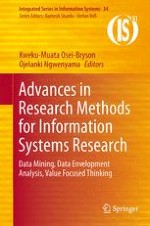2014 | OriginalPaper | Chapter
4. An Approach for Using Data Mining to Support Theory Development
Authors : Kweku-Muata Osei-Bryson, Ojelanki Ngwenyama
Published in: Advances in Research Methods for Information Systems Research
Publisher: Springer US
Activate our intelligent search to find suitable subject content or patents.
Select sections of text to find matching patents with Artificial Intelligence. powered by
Select sections of text to find additional relevant content using AI-assisted search. powered by
